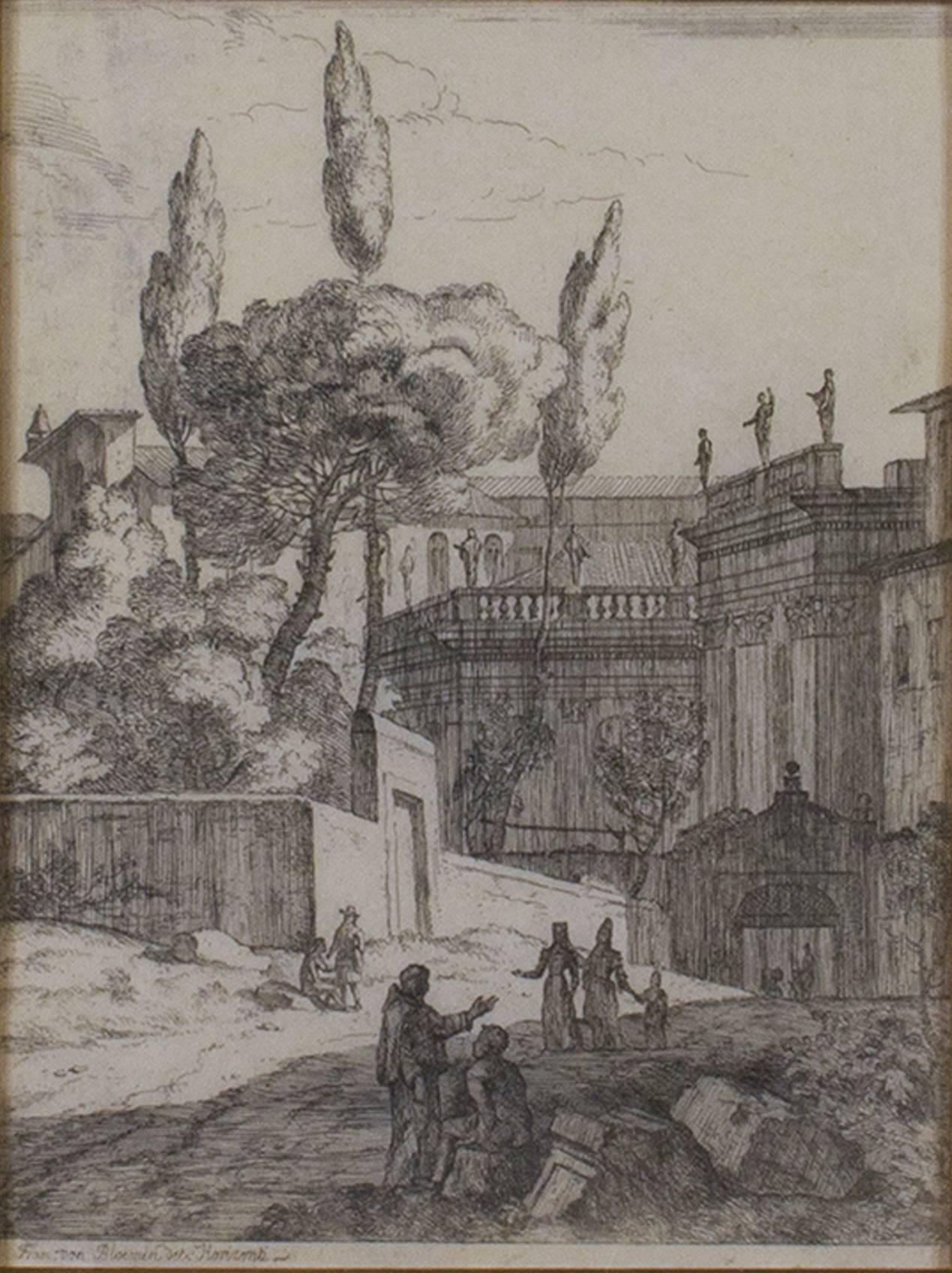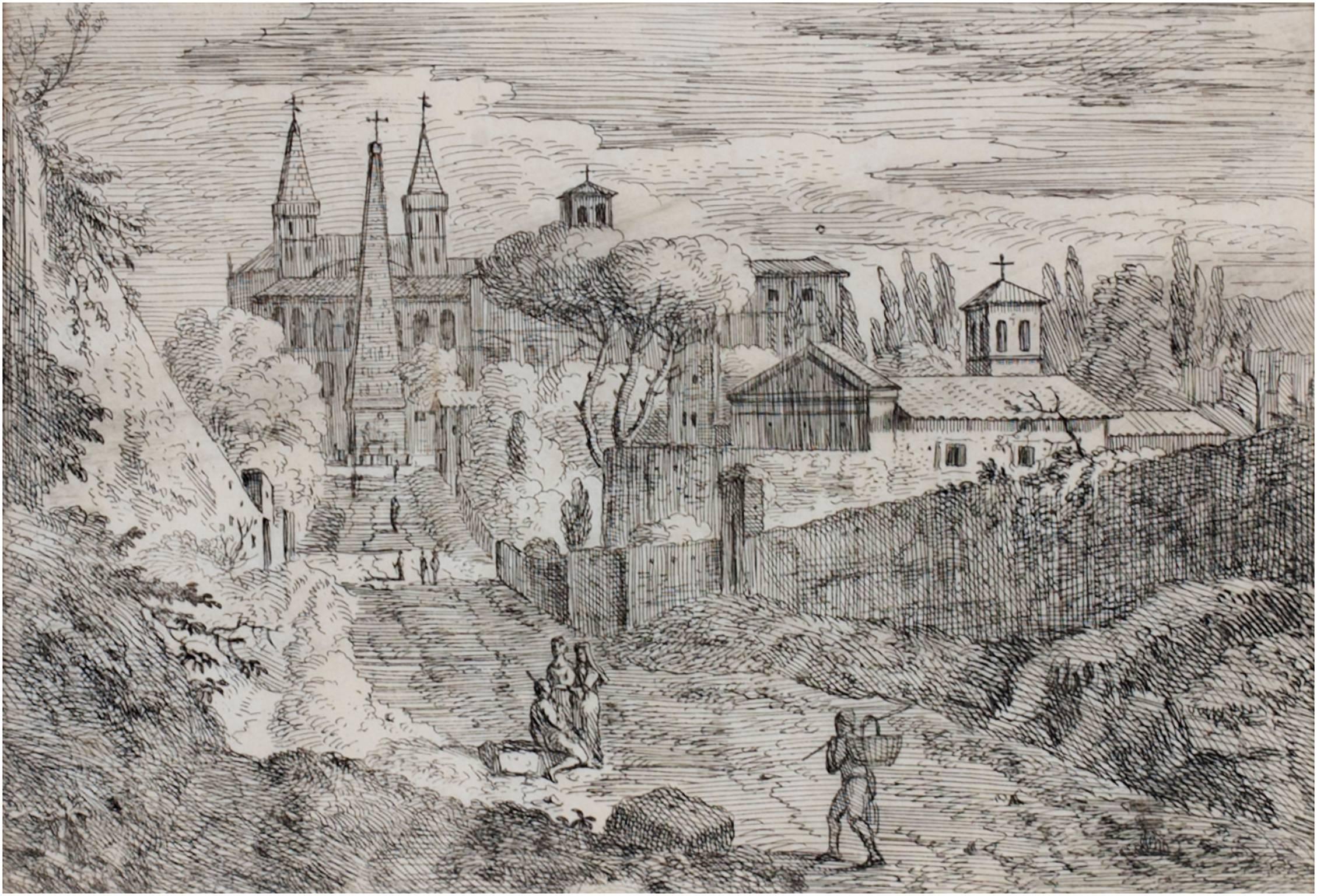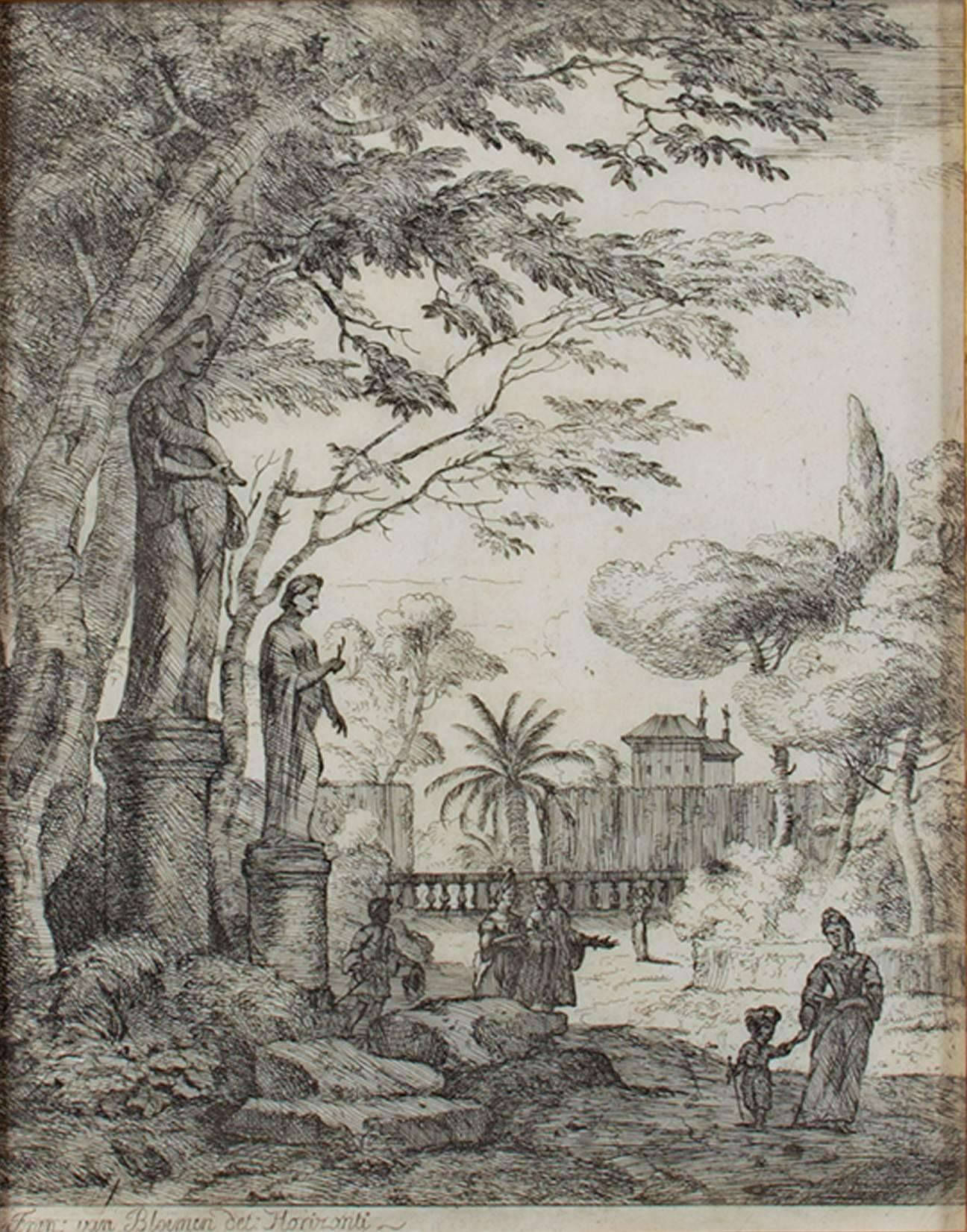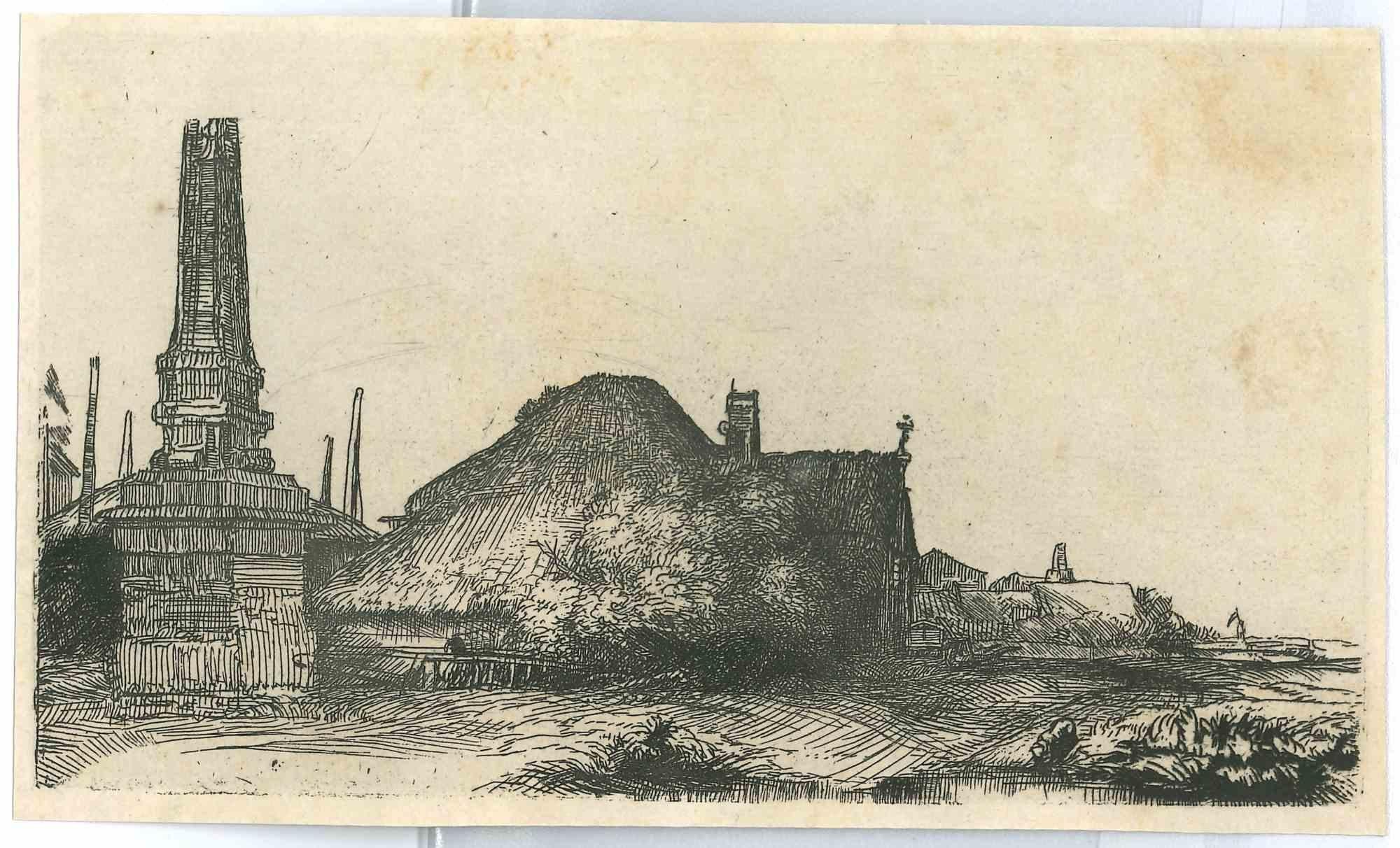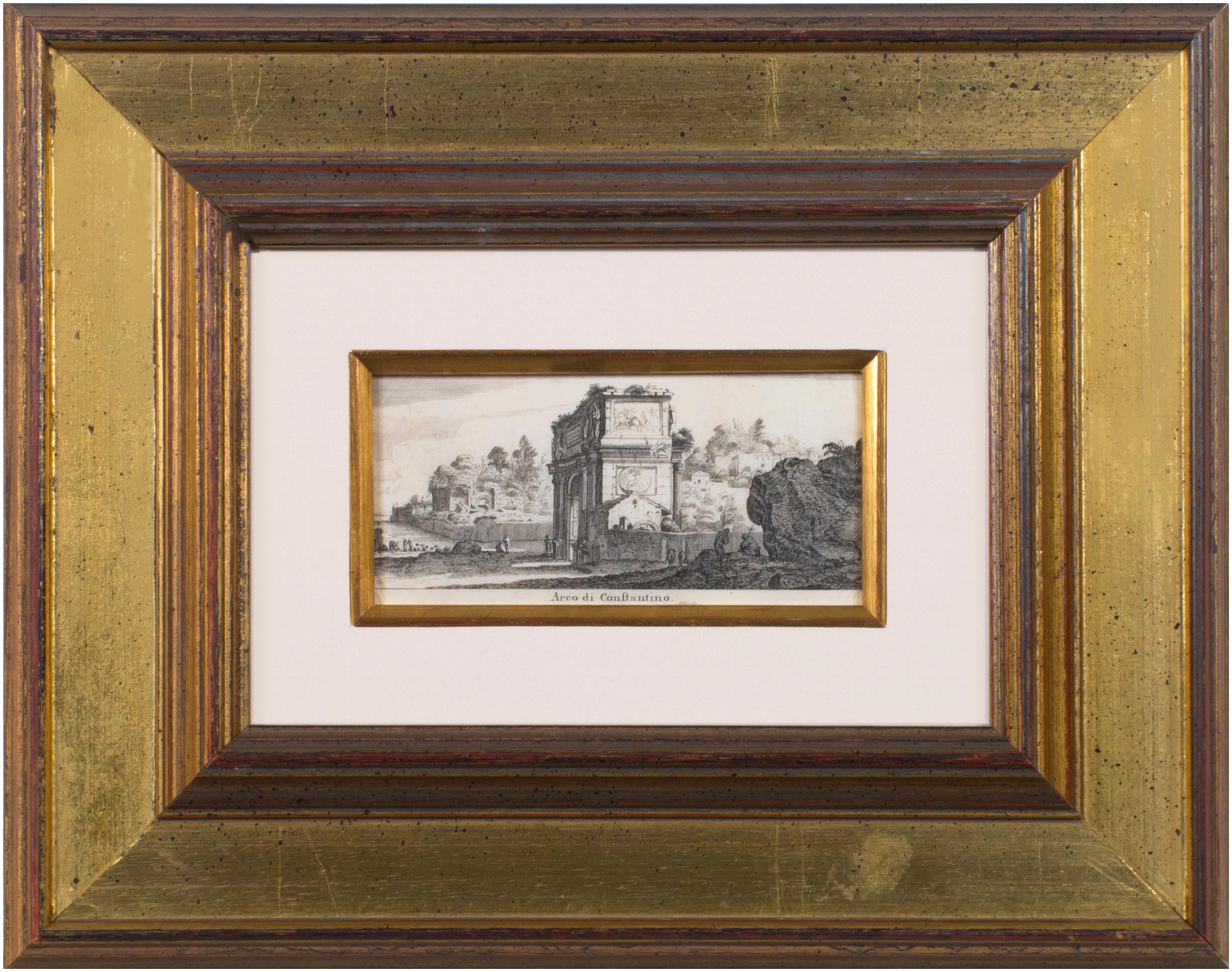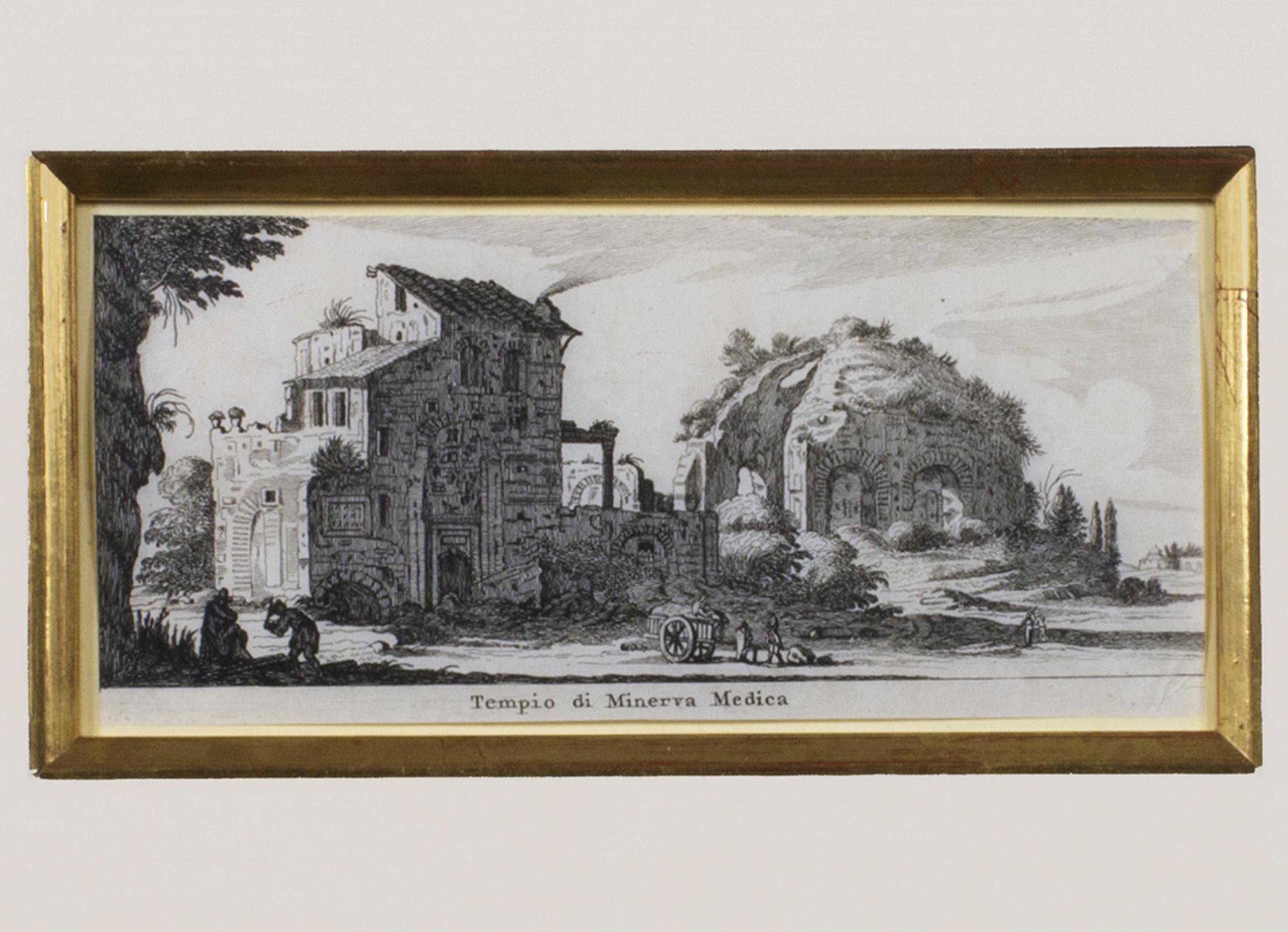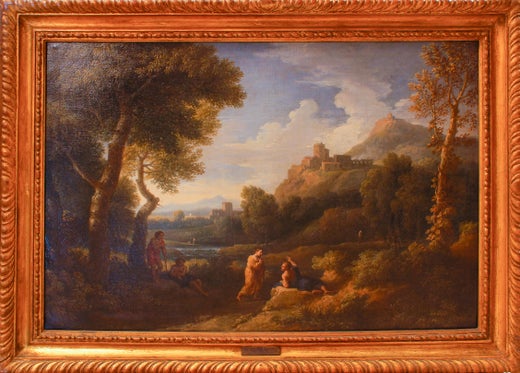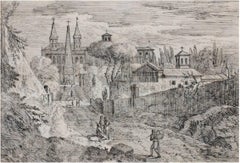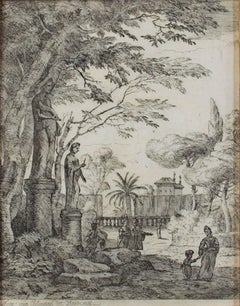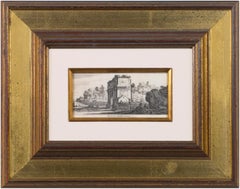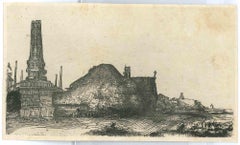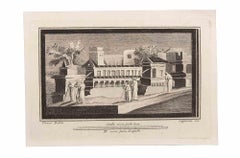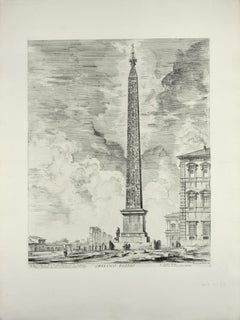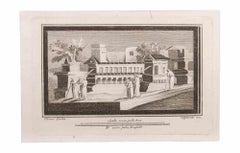Items Similar to 17th century etching black and white figurative landscape obelisk buildings
Want more images or videos?
Request additional images or videos from the seller
1 of 8
Jan Frans van Bloemen (Orizzonte)17th century etching black and white figurative landscape obelisk buildings1670-1746
1670-1746
$1,700
£1,290.95
€1,492.26
CA$2,389.19
A$2,660.36
CHF 1,406.86
MX$32,374.93
NOK 17,733.78
SEK 16,707.83
DKK 11,137.13
About the Item
"Figures at the Obelisk" is an original etching by Jan Frans van Bloemen. It depicts two people conversing in front of a monument. Behind them, an expansive landscape sprawls.
9 1/4" x 6 3/4" art
21 3/4" x 19 3/8" frame
Jan Frans van Bloemen (baptized 12 May 1662 - buried 13 June 1749) was a Flemish landscape painter mainly active in Rome. Here he was able to establish himself as the leading painter of views (vedute) of the Roman countryside depicted in the aesthetic of the classical landscape tradition.
Van Bloemen predominantly painted classical landscapes, taking his inspiration from the Roman Campagna. His landscapes, with their recession through a series of planes, soft, warm lightning and classical and religious subject matter, drew on the examples of artists such as Claude Lorrain and Gaspard Dughet. His paintings are exquisitely imbued with that "difficult-to-define pastoral ambience" which helped to make him such a great painter in the eyes of his contemporaries. The technique and subjects of the work of Jan Frans van Bloemen are also related to painters such as Jan Asselijn, Thomas Wyck, Willem Romeyn and Willem Schellinks. His painted vedute fall into the category of the vedute that combine reality with imaginary elements.
His landscapes have an Arcadian lushness, with mountains, streams, distant hamlets, and small inhabitants painted with imprecise pittura di tocco ('painting of touch') using small dotting and spirited brush-strokes. Unlike van Wittel, van Bloemen did not generally depict views of areas distant from Rome such as the Tiber valley or the Alban hills. His subjects were limited to views in the immediate vicinity of Rome, an outline of which was typically visible in his compositions. Van Bloemen was in particular known for his 'estate views' representing the estates of the nobility in the Roman Campagna. His views aim to associate the modern estate view with the classical arcadian landscape. Rather than offering the wide panoramic views, distant horizon and atmospheric effects associated with topographical landscapes, van Bloemen's estate views emphasize minute observation of reality and a limited viewpoint. The estates are thus made to appear as immutable features of the local landscape.
He worked together with other painters who painted the figures in his landscapes such as Carlo Maratti, Placido Costanzi and Pompeo Batoni. However, he only relied on such collaboration with figure painters in the last decades of his life when he produced his most ambitious classicising compositions. Even then he only relied on these figure specialists for the most prominent figures in the foreground while he took care of the minor characters. In fact, van Bloemen was an accomplished staffage painter and he was very skilled at quickly learning to imitate the style of his collaborators. As a result, many of the figures in his paintings that are attributed to prestigious contemporaries were actually by his own hand. He collaborated most frequently with Placido Costanzi. He regarded the pair of paintings representing The Flight to Egypt and The Rest on the Flight to Egypt as his best collaboration with Placido Costanzi who painted the figures.
His landscape drawings, which often depict imaginary ruins, have been confused with those of his brother Pieter, who is better known for his drawings of figures and animals. Jan Frans van Bloemen also made pen drawings of buildings in and around Rome.
- Creator:Jan Frans van Bloemen (Orizzonte) (1662-1749, Flemish)
- Creation Year:1670-1746
- Dimensions:Height: 21.75 in (55.25 cm)Width: 19.375 in (49.22 cm)
- Medium:
- Movement & Style:
- Period:
- Condition:
- Gallery Location:Milwaukee, WI
- Reference Number:Seller: 10689g1stDibs: LU60532829903
Jan Frans van Bloemen (Orizzonte)
Jan Frans van Bloemen (baptized 12 May 1662 - buried 13 June 1749) was a Flemish landscape painter mainly active in Rome. Here he was able to establish himself as the leading painter of views (vedute) of the Roman countryside depicted in the aesthetic of the classical landscape tradition. Van Bloemen predominantly painted classical landscapes, taking his inspiration from the Roman Campagna. His landscapes, with their recession through a series of planes, soft, warm lightning and classical and religious subject matter, drew on the examples of artists such as Claude Lorrain and Gaspard Dughet. His paintings are exquisitely imbued with that "difficult-to-define pastoral ambience" which helped to make him such a great painter in the eyes of his contemporaries. The technique and subjects of the work of Jan Frans van Bloemen are also related to painters such as Jan Asselijn, Thomas Wyck, Willem Romeyn and Willem Schellinks. His painted vedute fall into the category of the vedute that combine reality with imaginary elements. His landscapes have an Arcadian lushness, with mountains, streams, distant hamlets, and small inhabitants painted with imprecise pittura di tocco ('painting of touch') using small dotting and spirited brush-strokes. Unlike van Wittel, van Bloemen did not generally depict views of areas distant from Rome such as the Tiber valley or the Alban hills. His subjects were limited to views in the immediate vicinity of Rome, an outline of which was typically visible in his compositions. Van Bloemen was in particular known for his 'estate views' representing the estates of the nobility in the Roman Campagna. His views aim to associate the modern estate view with the classical arcadian landscape. Rather than offering the wide panoramic views, distant horizon and atmospheric effects associated with topographical landscapes, van Bloemen's estate views emphasize minute observation of reality and a limited viewpoint. The estates are thus made to appear as immutable features of the local landscape. He worked together with other painters who painted the figures in his landscapes such as Carlo Maratti, Placido Costanzi and Pompeo Batoni. However, he only relied on such collaboration with figure painters in the last decades of his life when he produced his most ambitious classicising compositions. Even then he only relied on these figure specialists for the most prominent figures in the foreground while he took care of the minor characters. In fact, van Bloemen was an accomplished staffage painter and he was very skilled at quickly learning to imitate the style of his collaborators. As a result, many of the figures in his paintings that are attributed to prestigious contemporaries were actually by his own hand. His landscape drawings, which often depict imaginary ruins, have been confused with those of his brother Pieter, who is better known for his drawings of figures and animals. Jan Frans van Bloemen also made pen drawings of buildings in and around Rome.
About the Seller
4.9
Platinum Seller
Premium sellers with a 4.7+ rating and 24-hour response times
Established in 1966
1stDibs seller since 2017
437 sales on 1stDibs
Typical response time: 3 hours
- ShippingRetrieving quote...Shipping from: Milwaukee, WI
- Return Policy
Authenticity Guarantee
In the unlikely event there’s an issue with an item’s authenticity, contact us within 1 year for a full refund. DetailsMoney-Back Guarantee
If your item is not as described, is damaged in transit, or does not arrive, contact us within 7 days for a full refund. Details24-Hour Cancellation
You have a 24-hour grace period in which to reconsider your purchase, with no questions asked.Vetted Professional Sellers
Our world-class sellers must adhere to strict standards for service and quality, maintaining the integrity of our listings.Price-Match Guarantee
If you find that a seller listed the same item for a lower price elsewhere, we’ll match it.Trusted Global Delivery
Our best-in-class carrier network provides specialized shipping options worldwide, including custom delivery.More From This Seller
View All17th century etching black and white figurative landscape trees buildings
By Jan Frans van Bloemen (Orizzonte)
Located in Milwaukee, WI
"Conversation Outside Castle" is an original etching by Jan Frans van Bloemen. It depicts a number of figures just outside the majestic walls of a castle. These groups of figures are engaged in their own conversations.
9" x 6 3/4" art
21 5/8" x 19 3/8" frame
Jan Frans van Bloemen (baptized 12 May 1662 - buried 13 June 1749) was a Flemish landscape painter mainly active in Rome. Here he was able to establish himself as the leading painter of views (vedute) of the Roman countryside depicted in the aesthetic of the classical landscape tradition.
Van Bloemen predominantly painted classical landscapes, taking his inspiration from the Roman Campagna. His landscapes, with their recession through a series of planes, soft, warm lightning and classical and religious subject matter, drew on the examples of artists such as Claude Lorrain and Gaspard Dughet. His paintings are exquisitely imbued with that "difficult-to-define pastoral ambience" which helped to make him such a great painter in the eyes of his contemporaries. The technique and subjects of the work of Jan Frans van Bloemen are also related to painters such as Jan Asselijn...
Category
18th Century Old Masters Landscape Prints
Materials
Etching
17th century etching black and white figurative landscape cityscape buildings
By Jan Frans van Bloemen (Orizzonte)
Located in Milwaukee, WI
"Figures Outside the Monastery" is an original etching by Jan Frans van Bloemen. It depicts people on the path to a church.
7" x 10 1/4" art
19 1/4" x 22 5/8" frame
Jan Frans van Bloemen (baptized 12 May 1662 - buried 13 June 1749) was a Flemish landscape painter mainly active in Rome. Here he was able to establish himself as the leading painter of views (vedute) of the Roman countryside depicted in the aesthetic of the classical landscape tradition.
Van Bloemen predominantly painted classical landscapes, taking his inspiration from the Roman Campagna. His landscapes, with their recession through a series of planes, soft, warm lightning and classical and religious subject matter, drew on the examples of artists such as Claude Lorrain and Gaspard Dughet. His paintings are exquisitely imbued with that "difficult-to-define pastoral ambience" which helped to make him such a great painter in the eyes of his contemporaries. The technique and subjects of the work of Jan Frans van Bloemen are also related to painters such as Jan Asselijn, Thomas Wyck...
Category
18th Century Old Masters Landscape Prints
Materials
Etching
17th century etching black and white figurative landscape trees statues scene
By Jan Frans van Bloemen (Orizzonte)
Located in Milwaukee, WI
"Mother & Child Near Statues" is an original etching by Jan Frans van Bloemen. It depicts two figures, a mother and child pair, next two two classical statues. There are other figures in this park-like environment.
9 1/4" x 6 3/4" art
21 5/8" x 19 3/8" frame
Jan Frans van Bloemen (baptized 12 May 1662 - buried 13 June 1749) was a Flemish landscape painter mainly active in Rome. Here he was able to establish himself as the leading painter of views (vedute) of the Roman countryside depicted in the aesthetic of the classical landscape tradition.
Van Bloemen predominantly painted classical landscapes, taking his inspiration from the Roman Campagna. His landscapes, with their recession through a series of planes, soft, warm lightning and classical and religious subject matter, drew on the examples of artists such as Claude Lorrain and Gaspard Dughet. His paintings are exquisitely imbued with that "difficult-to-define pastoral ambience" which helped to make him such a great painter in the eyes of his contemporaries. The technique and subjects of the work of Jan Frans van Bloemen are also related to painters such as Jan Asselijn...
Category
18th Century Old Masters Landscape Prints
Materials
Etching
17th century engraving black and white landscape ancient building scene
By Israel Silvestre
Located in Milwaukee, WI
In the mid-seventeenth century, views of historic landscapes and classical structures were increasingly popular among print collectors, and artists like the Frenchman Israel Sylvestre were eager to fill that demand. In this example, Sylvestre captures a view of the Arch of Constantine...
Category
Mid-17th Century Baroque Landscape Prints
Materials
Engraving
17th century engraving black and white landscape ancient building scene
By Israel Silvestre
Located in Milwaukee, WI
"Tempo di Minerva Medica" is an original engraving by Israel Silvestre, titled along the lower edge. This miniature print depicts the ruins of the Temple of Minerva Medica in the Rom...
Category
1650s Baroque Landscape Prints
Materials
Engraving
17th century engraving black and white landscape ancient building scene
By Israel Silvestre
Located in Milwaukee, WI
"Tempio Della Pace" is an original engraving by Israel Silvestre. The title is printed below the miniature image. It shows a frontal view of the remains of the Temple of Peace in Rom...
Category
1650s Old Masters Landscape Prints
Materials
Paper, Ink, Engraving
You May Also Like
Landscape with an Obelisk - Engraving after Rembrandt - 19th Century
By Charles Amand Durand
Located in Roma, IT
Landscape with an Obelisk is an engraving on ivory-colored paper realized after an etching by Rembrandt dated 1650 ca. This wonderful piece of art belongs to an edition of the late 1...
Category
19th Century Old Masters Figurative Prints
Materials
Engraving
Landscape with Monuments and Figures - Etching by F. Cepparuli - 18th Century
By Francesco Cepparuli
Located in Roma, IT
Landscape With Monuments and Figures is an Etching realized by Francesco Cepparuli (1750-1767).
The etching belongs to the print suite “Antiquities of Herculaneum Exposed” (origina...
Category
Late 18th Century Old Masters Figurative Prints
Materials
Etching
Obelisco Egizio (Egyptian Obelisk) - Etching by G. B. Piranesi
By Giovanni Battista Piranesi
Located in Roma, IT
Obelisco Egizio (The Egyptian Obelisk in the Piazza di S. Giovanni), erected by Pope Sixtus V, is a wonderful black and white etching on fine laid and watermarked paper (with a lily inside a double circle, watermark n. 3 according to Hind) realized by Giovanni Battista Piranesi.
Signed on plate on the lower right margin "Piranesi Architetto fec." and with the address and price at lower left. Hind 53, second state of five. A lifetime Roman impression, before the Paris editions.
Excellent condition, with central fold, as issued, visible only on the left margin.
From one of the most important series of etchings by G.B. Piranesi, Views of Rome drawn and etched by Giambattista Piranesi...
Category
1750s Old Masters Landscape Prints
Materials
Etching
Landscapes with Monuments and Figures - Etching by F. Cepparuli - 18th Century
By Francesco Cepparuli
Located in Roma, IT
Landscape With Monuments and Figures is an Etching realized by Francesco Cepparuli (1750-1767).
The etching belongs to the print suite “Antiquities of Herculaneum Exposed” (origina...
Category
Late 18th Century Old Masters Figurative Prints
Materials
Etching
Piazza del Popolo - Original Etching by Giuseppe Vasi - 18th century
By Giuseppe Vasi
Located in Roma, IT
Piazza del Popolo is a vintage offset print realized after Giuseppe Vasi in the early 20th Century.
Good conditions and aged margins with some foxings.
Giuseppe Vasi (Corleone,171...
Category
18th Century Modern Figurative Prints
Materials
Etching
Obelisco Egizio (Egyptian Obelisk) from Vedute di Roma Etching by Piranesi
By Giovanni Battista Piranesi
Located in New York, NY
Obelisco Egizio from "Vedute di Roma" by Giovanni Battista Piranesi.
2nd Roman state, 1759-1778. Etching on laid paper with a watermark of a Fleur-de-L...
Category
Late 18th Century Prints and Multiples
Materials
Paper
